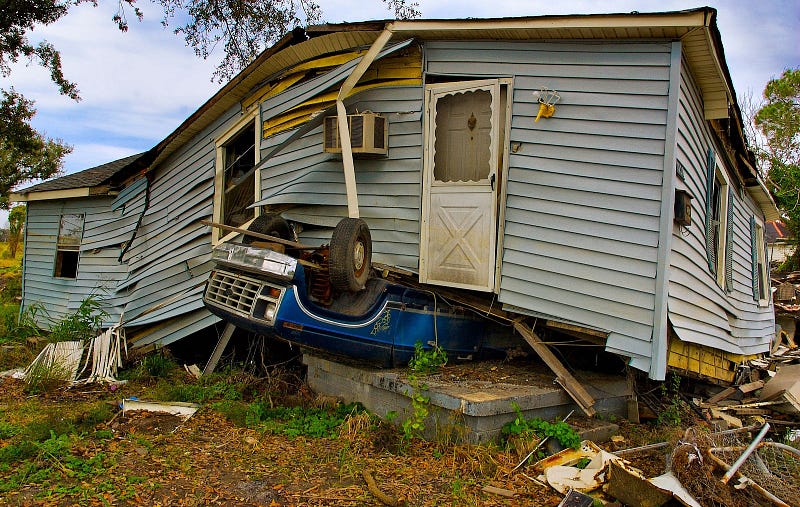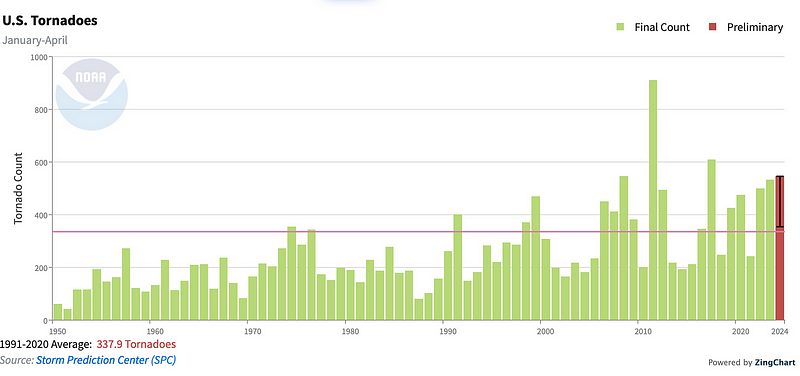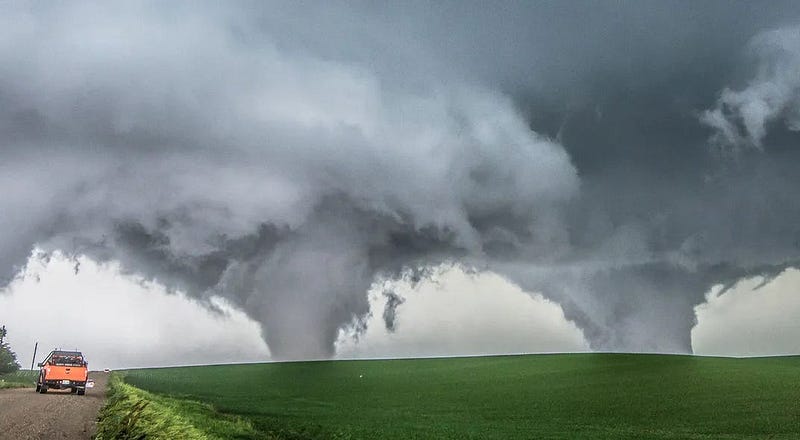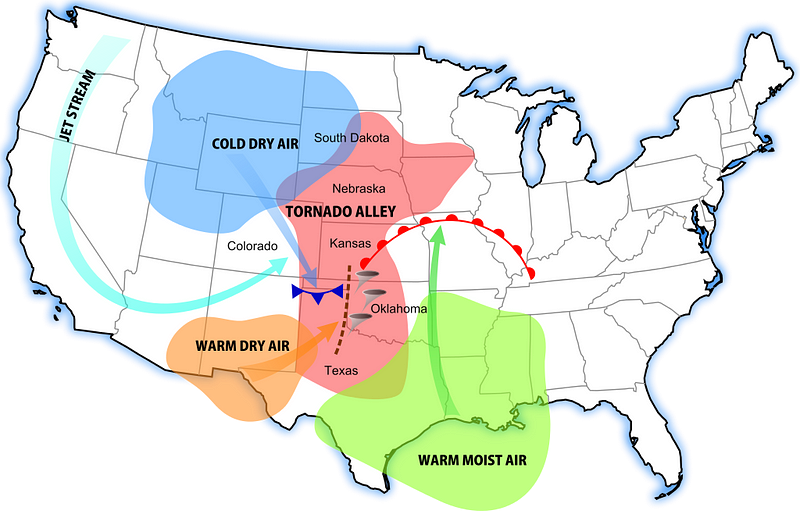Emerging Tornado Trends: A Shift in Patterns and Risks
Written on
Understanding the New Tornado Landscape
The much-anticipated movie "Twisters" is set to become a summer hit, featuring a group of daring storm chasers racing against time to track down devastating twin tornadoes threatening a small Ohio town. However, this isn't merely a cinematic creation; meteorological conditions can indeed produce multiple tornadoes at once. Alarmingly, experts are warning that this scenario is just one indication of more hazardous tornado activity on the horizon—not only in traditional Tornado Alley but also in densely populated cities like Chicago, Atlanta, and Washington D.C.
According to preliminary data from the National Center for Environmental Information (NCEI), there were 547 tornadoes reported in the United States during the first four months of the year. Though May's numbers have yet to be finalized, initial reports suggest over 500 tornadoes—nearly double the national average of 268 for that month.

Source: National Center for Environmental Information (NCEI)
Once May's statistics are confirmed, the total for 2024 could reach approximately 1,047 tornadoes by this point in the year—the second-highest total recorded, following 2011's figure of 1,238.
Changing Patterns and Their Implications
The rising number of tornadoes is concerning, but it’s not the only puzzle for meteorologists. Two notable trends are emerging:
- Timing of Tornado Outbreaks: Tornadoes are occurring more frequently in clusters, rather than being spread out over time. As highlighted in the "Twisters" film, this clustering means tornadoes are more likely to strike within narrow timeframes.

- Geographic Expansion: Tornadoes are straying far from their usual territories in Tornado Alley, causing damage in less familiar areas such as Florida, Tennessee, Kentucky, Illinois, and Indiana.
Recent events exemplify these trends. Over Memorial Day weekend, the Dallas/Fort Worth region experienced hail larger than grapefruits alongside a series of violent tornadoes. Similarly, four tornadoes struck Gilmer County, Georgia—a rural locale over 250 miles from the traditional Tornado Alley.
Shifts in Tornado Frequency
Historically, tornadoes were predominantly isolated events. Between the 1950s and 1970s, nearly 70% of tornadoes occurred on days with fewer than ten. However, a 2019 study indicates that since 2000, less than half of tornadoes have occurred on quieter days, while the instances of outbreaks featuring 20 or more tornadoes have tripled. This indicates a trend where tornadoes are becoming more clustered and intense.
Tyler Fricker, a co-author of the study and professor at the University of Louisiana Monroe, noted that tornadoes now frequently occur within outbreak environments. This clustering effect can be deadly, as multiple tornadoes striking in quick succession can enhance their destructive potential. Furthermore, numerous alerts can overwhelm residents, complicating their preparations for safety.
A New Tornado Alley?
While tornadoes can strike at any time, spring remains the most perilous season, particularly in April, May, and June. This period sees a high concentration of tornadoes, primarily in Tornado Alley, where cold northern air collides with warm, moist air from the Gulf of Mexico.

Despite Tornado Alley’s historical vulnerability, tornado activity is shifting eastward by 400 to 500 miles, according to a 2018 study. Victor Gensini, the study's lead author, stated, “Southeast and Midwest regions are catching up in tornado frequency.” While Texas and Oklahoma remain leading areas for tornadoes, recent trends indicate a decline in activity over the past four decades.
This shift poses significant challenges. More populated regions are now at greater risk, and residents may lack familiarity with tornado preparedness due to the unfamiliarity of such storms in their vicinity.
Increased Vulnerability of the Southeast
The Southeast faces unique challenges when it comes to tornado preparedness. Unlike the expansive plains of the Great Plains, this hilly region can obstruct views for weather monitors and storm chasers. Additionally, prevailing winds often bring moisture from the Gulf of Mexico, resulting in more nighttime tornadoes, which are statistically more dangerous—being 2.5 times more likely to cause fatalities.
Exploring the Causes: Is Climate Change a Factor?
While the reasons for these evolving tornado patterns remain uncertain, many scientists hesitate to pin the changes solely on climate change. Tornadoes are relatively small-scale phenomena, making them difficult to quantify in global climate models. However, some researchers contend that climate change is indeed influencing severe thunderstorm formation, which could lead to larger outbreaks.
William Gallup, a meteorologist at Iowa State University, notes, “With climate change, areas previously too cold in winter are experiencing conditions that now allow for tornadoes during unexpected times of the year.”
Misunderstanding Tornado Warnings
Despite the increasing severity of tornado activity, research reveals a significant knowledge gap regarding tornado safety. A recent study found that many individuals in the mid-south (Tennessee, Missouri, Arkansas, and Mississippi) struggle to differentiate between a tornado warning—indicating a confirmed tornado—and a tornado watch, which merely suggests favorable conditions for tornado formation.

Understanding these nuances is essential for effective response, as emphasized by Cory Armstrong, a professor at the University of Nebraska-Lincoln and lead author of the study published in the Journal of Extreme Events.
Preparation for Severe Weather
The Federal Emergency Management Agency (FEMA) advises individuals under a tornado warning to:
- Seek shelter immediately.
- Move to a safe room, basement, storm cellar, or an interior room on the lowest floor.
- Avoid windows, doors, and outside walls.
- Do not take shelter under an overpass or bridge; a low, flat area is safer.
- Be mindful of flying debris that may cause harm.
- Protect your head and neck with your arms.
While experts debate the causes of these tornado trends, they agree that increased awareness and preparedness are essential for communities facing the new reality of severe weather. As James Elsner, a distinguished researcher, noted, today’s tornadoes present “ominous indicators,” highlighting the need for continued investigation into these phenomena.
The first video titled "Real Life Twisters: Chasing Destructive Tornados" provides a gripping look into the real-life challenges faced by storm chasers and the destructive power of tornadoes.
The second video, "MULTI-WEDGE TORNADO OUTBREAK IN TWISTED," showcases the intensity of tornado outbreaks and their impact on various regions.